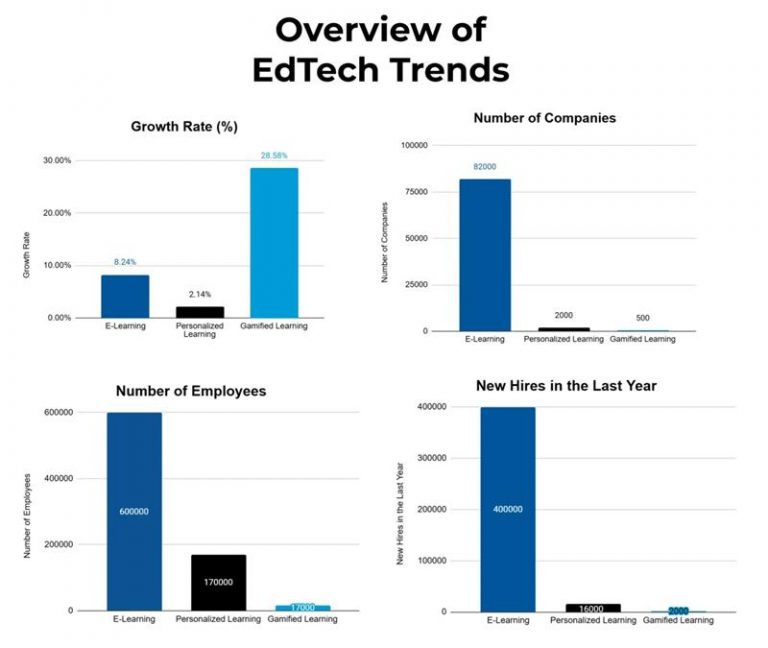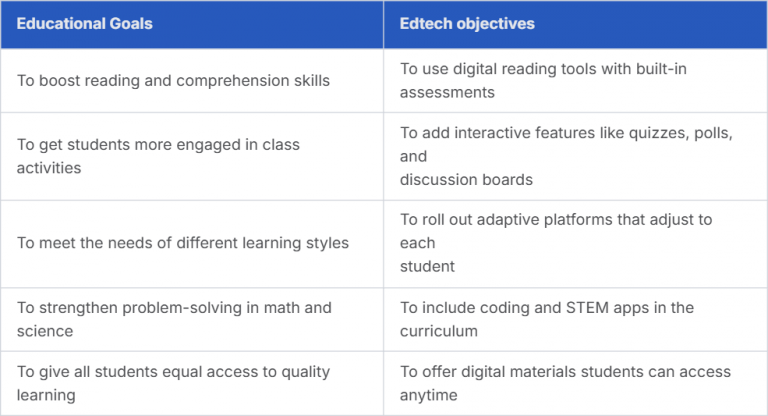There’s no denying the power of technology in today’s business landscape. It has infiltrated various industries to improve different operations, including the education sector. Think of popular EdTech trends, such as e-learning, personalisation, and gamification.

It’s no secret to gatekeep: Schools are now investing in EdTech. Are you ready to jump on the tech bandwagon in education? But how can you use these technological resources to get ahead of the curve?
This page covers the key areas for a highly impactful EdTech investment you should consider. Read on to learn how to use these tools to gain a competitive academic edge.
Key Areas for High-impact EdTech Investment
EdTech stands for education technology—the use of digital tools and platforms in educational settings, such as schools or other institutions. A perfect example is the adoption of communication technologies, such as Zoom, Skype, and Slack, used for online classes during the pandemic. However, there’s more to this than meets the eye.
To fully maximise the benefits offered by the EdTech stack, consider four key areas:
- Data-driven assessment tools: Use technologies to gather and collect datasets that will help you make informed decisions in education.
- Personalised learning platforms: Utilise tools to align learning styles with students’ needs to personalise the experience.
- Blended learning infrastructure: Employ digital tools and platforms to give access to learning, whether in the classroom or at home.
- Mentor training and support tools: Leverage technological resources to empower teachers in their day-to-day teaching endeavours.
Let’s take Classe365 as a perfect example of EdTech. This robust platform offers tech solutions, such as a pre-admission and enrollment database, student information system, learning management system (LMS), customer relationships management (CRM), finance and accounting platform, and more.

As you can see, AI-powered and unified tools like Classe365 enable schools to manage various aspects of their operations, from handling college admissions to promoting alumni networking. They usually offer complete solutions for the education sector as a way to generally enhance the learning experience.
It’s now easy to see schools investing in EdTech due to its various potential benefits. The worldwide EdTech market is projected to grow from $92.90 billion in 2025 to $705.75 billion by 2034 at a 15.50% compound annual growth rate (CAGR). This market growth is due to the following:
- The increasing demand for online learning solutions
- The growing technological adoption in the education sector.

If you’re looking to invest in Edtech and gain a competitive advantage, you must strategise your investment. Learn how to leverage tools and technologies to outperform other schools in the next section.
How To Use EdTech for Competitive Academic Edge
Educational institutions have already integrated some forms of technology into their systems. However, the most innovative ones are investing in EdTech tools and platforms. Their investments allow them to compete with other schools while creating a high impact in the community, and increase their return on investment (ROI).
If you plan to use EdTech to gain competitive advantage, here’s what you need to do:
1. Set academic goals and tech objectives
The initial step is to review your educational goals and set new ones based on current needs. Then, you have to see how digital tools and platforms can help you achieve them. Ultimately, matching tech objectives with academic goals is key to achieving academic success!
Take a look at the table below, for instance. It shows what your current academic goals are and how your tech objectives will help you achieve these. Use this as your reference for your Edtech investment from the get-go:

2. Conduct needs assessments and tech audits
The next step is to dig deeper into your academic needs. What does your school require to achieve your academic goals? Then, conduct a thorough examination of your current technology. What tools and platforms can help meet your educational needs? Here’s what you need to do:
- Needs assessments: Sit down with key leaders from your various stakeholders and see what your school precisely needs. Are your students having some learning gaps? Do your teachers need some support and resources? Do your learning materials require updates and optimisation?
- EdtTech audits: Review the technologies integrated with your school systems. Then, examine how EdTech resources can help. Do you need to invest in communications technologies for e-learning? How can automation help accelerate admin tasks and AI assist in generating learning materials?
Nicolas Breedlove, CEO at PlaygroundEquipment.com, highlights the impact of technology on all sectors. She recommends investing in digital tools and advanced technologies, no matter the industry. For instance, she suggests leveraging EdTech in education.
Breedlove says, “Technology has transformed every sector, and education is no exception. But before making any big investments, schools should take a hard look at what’s working, what’s missing, and how tech can directly support their goals.”
3. Research and pick the right technologies
Now, it’s time to look for reliable EdTech businesses and shop around for robust technologies.
The good news? Many companies and organisations have long been investing in EdTech to help schools succeed. However, take TIME magazine’s list of top companies as of 2025: See what digital tools and platforms they offer and if you can afford some of these.

However, consider EdTech resources that have a high impact on educational institutions. Below are digital tools and technologies for education you might want to consider:
- Learning management systems (Blackboard, Canvas, Moodle, Doceno, and TalentLMS)
- Personalised learning platforms (360 Learning, EdApp, Coursera, and edX)
- Quiz and assessment tools (Kahoot!, Quizizz, and Edpuzzle)
- Communication and collaboration tools (Microsoft Teams for Education, Zoom, and Slack)
- Student information systems (Classe365, Power School, Aeries, and Skyward)
Of course, the technological investments vary from one school to another. How do you decide what to invest in?
Case in point: A strong EdTech strategy should support the entire school community, not just academics. That means prioritising student and staff safety. Investing in tools for campus security, digital safety, and incident reporting is essential.
Still, accidents can happen. That’s why schools and families need to understand their legal rights and responsibilities. For those affected, knowing how to navigate injury compensation claims can be a key step toward recovery.
But as an educator, you can invest in some of these tools to manage various aspects of your school operations. However, what better way to capitalize on your EdTech investments than to hit those birds with one stone?
Enter Classe635, a unified platform that enables you to manage various functions for your educational institution—all in one place.
This EdTech solution covers almost everything, from pre-admission and enrollment to LMS and CRM to degree audit and alumni networking. With this tool in place, it’s a lot easier, faster, and better to ensure smooth operations and enhance learning.
4. Train and support your faculty members
After investing in EdTech resources, you need to train your teachers and provide them with the required support. The accurate measure of technological success is how they would maximise these tools to help meet your school’s needs. That said, Here’s how to support your faculty for success:
- Offer hands-on training sessions. These must be tailored to the specific tools your school uses.
- Create a go-to support system. This could be an EdTech coach, help desk, or peer mentoring program.
- Schedule ongoing refreshers. The goal is to keep up with updates and new features.
- Give teachers time to explore. Allow them to experiment with tech in low-stakes settings.
- Celebrate small wins. This helps build confidence and keep the momentum going.
When teachers feel confident using technology, they’re more likely to innovate, engage students, and drive better outcomes.
Learn from Grant Aldrich, Founder of Preppy. He provides his mentor-employees with the tools and resources they need to develop the best online courses for certification. He believes that equipping your employees with ample resources empowers them to make a difference.
Aldrich explains, “You can’t expect great results from technology if your people aren’t confident using it. Equip your employees with the tools, training, and support they need. Why? Because when they’re empowered, they create better learning experiences.”
5. Leverage data for decision-making
Data plays a crucial role in decision-making for every industry, including the education sector. That’s why it’s easy to see most schools leveraging big data analytics in education. With the help of EdTech, they can collect, analyse, and act on datasets to improve academic operations and outcomes.
How do you go about doing so? It starts with tracking school performance, student progress, and engagement across platforms. These insights can then guide key decisions around curriculum, teaching strategies, and more.
That said, here are areas in education where you can use data generated by EdTech:
- Student learning and performance: See how students are doing and catch problems early.
- Teacher training and support: Find out where teachers need help and what they’re doing well.
- Curriculum and instructional design: Spot which lessons need a refresh based on student results.
- Resource planning and allocation: Know what tools and resources are being used so you can spend smarter.
- School reporting and decision-making: Use real data to make better calls for your school.
6. Personalise the learning experience
Education typically follows standard approaches, but students learn in different ways. That’s why more schools are shifting to adaptive strategies that better fit individual learning needs. Personalising their learning experience is key!
Let’s take the use of artificial intelligence (AI) in education: AI is helping make that possible. Schools are now using tools like personalised tutoring systems and custom materials designed around each student’s learning style.
For example, technologies, such as voice AI, can generate realistic voiceovers, power interactive virtual tutors, and help bridge language gaps. This makes learning more flexible, inclusive, and engaging. Below are creative ways on how to personalise the learning experience:
- Start with setting individual goals. Help students set personal learning goals, allowing them to take ownership of their progress.
- Use adaptive learning platforms. Use tools that adjust content based on each student’s pace, level, and learning style.
- Offer self-study learning modules. Give students access to on-demand lessons so they can learn at their own speed.
- Provide options for projects/assignments. Let students choose how to show what they’ve learned, whether through videos, presentations, or written work.
- Leverage voice, video, and interactive tools. Utilise voice AI, videos, and interactive platforms to make lessons more engaging and accessible.
- Allow real-time feedback and support. Offer instant feedback through quizzes, chat tools, or AI tutors to guide learning as it happens.
- Incorporate gamification and rewards. Harness the power of extended reality or XR technology in higher education, whether virtual or augmented reality!
7. Offer online learning and hybrid setup
E-learning continues to grow in the education sector. In the UK alone, the market is projected to increase by $12.66 billion between 2025 and 2029, with a CAGR of 16.8%. This is driven by the need to improve how students learn.

While the pandemic accelerated online learning, many educational institutions have continued to adopt flexible formats. Today, it’s common to see schools offering both fully online programs and hybrid setups that blend in-person and virtual learning. Take note:
- Online learning: Online classes let students access lessons from anywhere. Whether it’s a live session or a self-paced module, e-learning makes education accessible to everyone. This is especially helpful to those with different schedules or limited physical access to schools.
- Blended setup: A blended setup combines in-person classes with online components. This model gives students the structure of classroom learning while offering the flexibility and personalisation of digital tools.
Schools now have a bigger role in preparing students for the future. With hybrid and remote work becoming more common, it’s no longer enough to focus only on core subjects.
Students also need soft skills, such as communication, collaboration, and adaptability, in virtual settings. Teaching them how to manage time zones, work across cultures, and apply remote performance management can give them a real advantage in tomorrow’s workforce.
8. Monitor, measure, and meet ROI targets
EdTech adoption brings real benefits, but its success depends on how well it’s tracked, measured, and improved over time.
To get the most value, schools need to focus on three key steps:
- Track. Monitor how tools are used across classrooms. Take a look at engagement, adoption rates, and learning outcomes!
- Assess. Consider the use of data in online education to measure performance. Identify what’s working and highlight areas that need attention!
- Improve. Optimise your EdTech strategy. You can do this by making data-informed updates, refining your tools, and supporting ongoing staff training.
Keep in mind that achieving a strong EdTech ROI is the ultimate goal. Schools invest in tools and technologies not just for profit but to add real value to student learning.
Before developing a long-term strategy, it’s essential to establish a clear financial plan. While upfront costs for hardware and software can be high, the long-term gains in student outcomes and efficiency often make it worthwhile.
For schools in competitive markets, especially in places like California, debt relief programs can alleviate financial pressure and free up funds to reinvest in essential EdTech resources.
Final Words
EdTech investment is a strategically wise move for schools in the education sector. Not only does it enhance the students’ learning, but it also provides mentors with help and support. Ultimately, it can contribute to your educational institution’s academic success!
To get started with your Edtech investment, consider the four key areas: datasets, personalisation, blended learning, as well as training and support. More importantly, follow our crucial steps above for using tools and technologies to compete with other schools.
Incorporating technology in education can make a world of difference in learning. Harness the power of EdTech to gain a competitive advantage! Classe365 offers robust EdTech tools and platforms to help manage various aspects of your school operations. To get started, sign up now for free!
